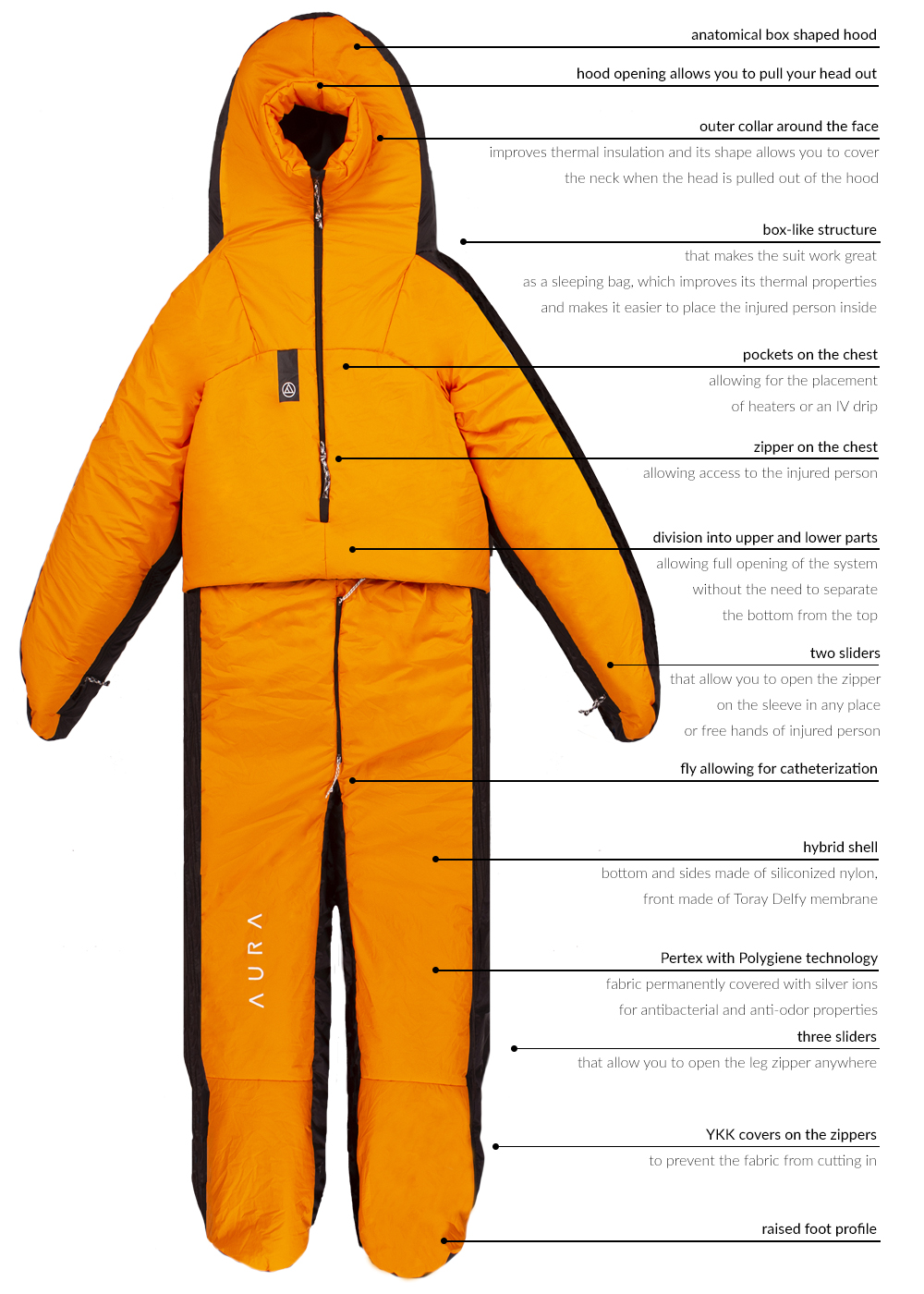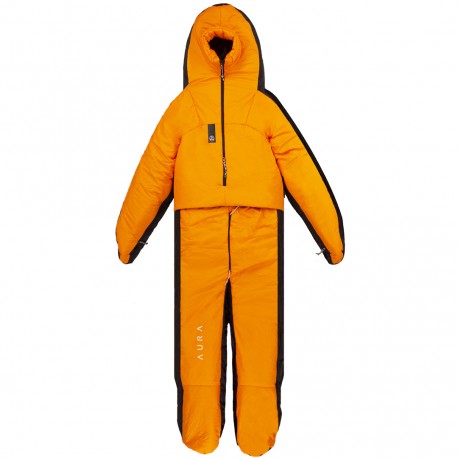RES-C
1 661 €
Data sheet
| DOWN WEIGHT (G) | |
| OVERALL WEIGHT (G) | |
| TYPE OF FILLER | |
| FABRIC |

RESCUE SYSTEMSThe solutions we proposed are unique and are a result of thoughtful examination of users' needs. They focus on the thermal aspect, the ease of securing the injured, access to the injured during medical procedures with minimal heat loss and compatibility with the rest of the equipment used during the action. At the moment, we have three products appropriately designed for first contact, transport in a sked stretcher and in a basket stretcher. SHAPE: SUITPROFILE: BOXBox is a profile in which the sides are formed by a separate component. This is a very comfortable profile. We use it in warmer sleeping bags where comfort is essential. CUT: LOOSETo facilitate comparison, we distinguished three fits: snug, regular and loose. |
1.COOPERATION WITH GOPRIn mid-2020, we started cooperation with Grupa Jurajska GOPR. The area of the Kraków-Częstochowa Upland is not associated with mountains, but, as few people know, it is full of caves. There is no other region in Poland with so many places for speleological activities. Talks with rescuers resulted in a plan to create three products that will fully protect the injured person during a rescue operation. Two compatible speleo stretchers for operation in the cave were designed. Anatomical in the shape of a suit for first contact and larger for placing in a stretcher. The third one was to protect the injured person during transport on the surface. We started with the latter. This is how RES-B was created. In the end it was the first anatomical system for operating in the cave. |

1.COOPERATION WITH GOPRIn mid-2020, we started cooperation with Grupa Jurajska GOPR. The area of the Kraków-Częstochowa Upland is not associated with mountains, but, as few people know, it is full of caves. There is no other region in Poland with so many places for speleological activities. Talks with rescuers resulted in a plan to create three products that will fully protect the injured person during a rescue operation. Two compatible speleo stretchers for operation in the cave were designed. Anatomical in the shape of a suit for first contact and larger for placing in a stretcher. The third one was to protect the injured person during transport on the surface. We started with the latter. This is how RES-B was created. In the end it was the first anatomical system for operating in the cave. |

2.ALL STARSWe started working on the speleo system by consulting rescuers. Thanks to the involvement of the initiator of the entire project, Janek Buczek from GOPR Jura, we managed to invite outstanding experts in cave operations and mountain rescue. We had the opportunity to work with four specialists: |
3.TESTS AND ECRA OPINIONTests are an important element of the product development process. Thanks to the involvement of the Jura Group, the test version was sent to the internal unification of GOPR cave sections and to several internal training courses and, what surprised us the most, to the ECRA talks, an organization associating cave rescuers from all over the world the system was very well received. Thanks to cooperation with rescuers, we were able to refine the ergonomics, dimensions and selection of fabrics. The final version has already been included in the Jura Group's assortment, received a positive assessment at the unification of GOPR medics and is now getting ready for presentation at the annual ECRA conference. |

3.TESTS AND ECRA OPINIONTests are an important element of the product development process. Thanks to the involvement of the Jura Group, the test version was sent to the internal unification of GOPR cave sections and to several internal training courses and, what surprised us the most, to the ECRA talks, an organization associating cave rescuers from all over the world the system was very well received. Thanks to cooperation with rescuers, we were able to refine the ergonomics, dimensions and selection of fabrics. The final version has already been included in the Jura Group's assortment, received a positive assessment at the unification of GOPR medics and is now getting ready for presentation at the annual ECRA conference. |

4.ASSUMPTIONSThe primary goal was, of course, thermal protection of the injured person. In addition, the system was supposed to allow for efficient positioning of the patient inside, provide easy access to him without having to unzip the whole thing, and be compatible with cave stretchers. This last assumption was associated with the greatest number of requirements. Speleo stretchers have straps that go from the shoulders to the armpits, from the hips to between the legs and around the calves. Additionally, it had to be as easy to use and compressible as possible. |
5.FORMRES-C is a sleeping bag in the shape of a suit. Thanks to its box-like cross-section, in which the sides are a separate structural element perpendicular to the top and bottom, RES-C has an exceptionally spacious shape. It has separated legs, arms and head, making it ideal for stretchers with belts for stabilizing the injured person, such as NEST or KONG. However, structurally it is closer to a sleeping bag. Thanks to its boxy cross-section, it is much more thermally efficient, spacious and maintains its shape regardless of the size of the person inside. |

5.FORMRES-C is a sleeping bag in the shape of a suit. Thanks to its box-like cross-section, in which the sides are a separate structural element perpendicular to the top and bottom, RES-C has an exceptionally spacious shape. It has separated legs, arms and head, making it ideal for stretchers with belts for stabilizing the injured person, such as NEST or KONG. However, structurally it is closer to a sleeping bag. Thanks to its boxy cross-section, it is much more thermally efficient, spacious and maintains its shape regardless of the size of the person inside. |

6.OPENINGThe bottom and side form the frame. They don't unzip. The zippers are placed in the edge between the sides and the top and allow the system to be fully opened. The span is divided into two areas. In order to prepare a product imitating the human figure, we had to divide it in such a way that it could be fully opened by unzipping as few zippers as possible. When we look at the outline of the human body, we will see that it changes clearly at the height, armpits and hips. In the abdominal and chest area it is straight. Hence the idea of the top interlocking between the armpits and the pelvis. Thanks to this, REC-C is easy to unzip with a minimum of operations, and when closed, the upper part fits over the lower part, eliminating heat loss. |
7.COMPACTOne of the main advantages of RES-C is its compactness. The system weighs 1.7 kg and after compression takes up a space of approximately 7 liters. At the same time, it ensures full thermal comfort in cave conditions. It's easy to add to your gear or even take it separately in a dedicated siliconized nylon bag. |

7.COMPACTOne of the main advantages of RES-C is its compactness. The system weighs 1.7 kg and after compression takes up a space of approximately 7 liters. At the same time, it ensures full thermal comfort in cave conditions. It's easy to add to your gear or even take it separately in a dedicated siliconized nylon bag. |

8.THERMAL SOLUTIONSThe most important solution to improve thermal insulation is the box section. It reduces the tension on the edges, which cause heat loss, and allows the zipper to be routed without disturbing the shape. Additionally, there is an external collar around the face that covers the hood opening and improves thermal insulation. The filling is Apex Climashield 100. What primarily distinguishes Climashield is its thermal advantages, no loss of insulating properties under pressure and resistance to moisture. |
9.ACCESSThe zippers running along the body to the feet are equipped with two additional sliders, thanks to which you can access the patient anywhere along the entire length of the zipper. Access to the hands is provided by a zipper running along the entire length of the sleeve. The chest can be accessed via the central zipper. We also placed a fly in the pelvic area allowing for catheterization. |

9.ACCESSThe zippers running along the body to the feet are equipped with two additional sliders, thanks to which you can access the patient anywhere along the entire length of the zipper. Access to the hands is provided by a zipper running along the entire length of the sleeve. The chest can be accessed via the central zipper. We also placed a fly in the pelvic area allowing for catheterization. |

10.FREEING HANDS AND HEADOne of the more surprising needs of the rescuers that we heard about during the consultation was the ability to free the injured person's hands and head so that he could freely use them. Therefore, the zipper on the sleeves can be unzipped from the hand side, creating an opening that allows you to pull out arms. The collar protecting the hood opening is designed so that it can also function as an anatomically profiled collar. After pulling the head out, it supports the neck in accordance with its structure, ensuring tight insulation. |
11.POCKETS ON THE CHESTThe element that we use in each of our systems to thermally protect the injured person are pockets on the chest in which rescuers can place chemical heaters or an IV drip. In RES-C you can access them through the central zipper on the frame. |

11.POCKETS ON THE CHESTThe element that we use in each of our systems to thermally protect the injured person are pockets on the chest in which rescuers can place chemical heaters or an IV drip. In RES-C you can access them through the central zipper on the frame. |

12.MOISTURECaves are all about moisture. That's why RES-C has a hybrid shell. The bottom and sides are protected with siliconized nylon. The upper is made of the Toray Delfy membrane, which also protects against moisture but also ensures breathability. |
13.CLIMASHIELDTo make RES-C, we used CLIMASHIELD 152 insulation. What distinguishes Climashield is its thermal advantages, durability and continuous structure that prevents movement. |

13.CLIMASHIELDTo make RES-C, we used CLIMASHIELD 152 insulation. What distinguishes Climashield is its thermal advantages, durability and continuous structure that prevents movement. |

14.POLYGIENEOur goal is to ensure the greatest possible comfort and the longest possible life of the products we put into your hands. That is why the lining with POLYGIENE technology plays such an important role in our offer. Thanks to silver ions that have antibacterial and antiodor properties, you can significantly extend the product's life cycle. |



























